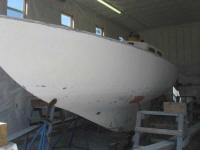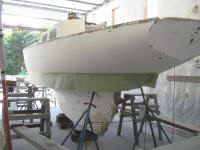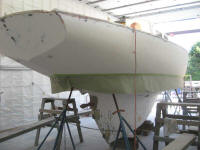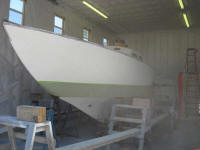

| Hattie
Mae | Thursday, May 21, 2009 I began on deck, and washed and sanded all yesterday's fairing patches, by machine and by hand as needed. This wrapped up most of the fairing work, excepting the large bulkhead patch, so before continuing I sanded out all the cockpit areas with the vibrating sander and 80-120 grits, to match the other deck areas that I'd completed earlier. With the sanding complete on deck, I cleaned up and applied some fine fairing compound to the bulkhead patch to fill some pinholes and minor low spots. |
|
Afterwards, I moved back down to the hull, and spent much of the rest of the day on four more rounds of sanding, as per usual: 80 and 120 grits on a vertical-axis random orbit finishing sander, and 80-120 grits on a vibrating palm sander. This repetitive sanding does a good job removing the harsher scratches left by the previous tool, and by moving through not only grits but also aggressiveness of the sanding tool itself, it helps ensure a smooth, fair, and properly-prepared surface. The hull was in good shape; some minor filling fairing had been taken care of during a much earlier phase of this project, before she came here (as had the bulk of the deck work), but the topsides were clearly in good shape, and I saw no need for further work at this time. As always, I planned on a round of final pinhole filling, as needed, following the high-build primer. |

 |
|
After completing the hull sanding, I cleaned up the shop, and then cleaned up the hull with vacuum and solvent to remove dust. Next, I masked off the waterline and boottop; to avoid losing the scribed-in marks for the boottop, which location we chose to reuse in this instance, I decided to mask off the boot area during the first round of primer. After taping, I applied paper below to prevent overspray. Next: final deck preparations. |

 
 |
|